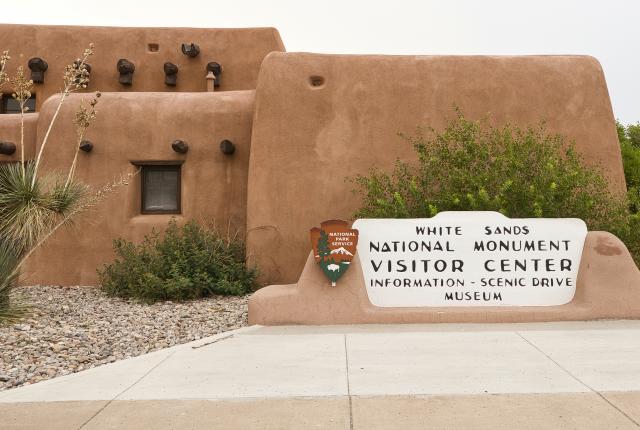A period-specific update to the historic visitor center’s sign is in the works. Photograph by Tira Howard.
DUCK INTO A DIM HALLWAY in the White Sands National Park visitor center for a welcome respite from the southern New Mexico sun. Around you, thick, plastered adobe walls feel cool. Log vigas traverse the low ceiling. Smooth terra-cotta tile covers the walkway. To step inside this historic building—part of a larger complex known as the White Sands Historic District—is to peel back the layers of time.
“One of the cool things is if you spend a little time looking at the structure, you’ll find out little secrets about it,” says Kelly Carroll, chief of interpretation for the park.
Built by craftsmen in the 1930s, the Lyle E. Bennett–designed structure used locally sourced materials for everything from handcrafted furniture to the earthen bricks that shape the building. Workers used traditional building techniques, helping to preserve those skills at a time when construction practices were swiftly changing.
Bennett styled the building after a mission church—a nod to the state’s architectural past, blending Spanish elements with the flat-roofed style of Native pueblos. Later, when the National Park Service developed facilities at parks throughout the Southwest, it tapped into an architectural trend, centered in New Mexico, that renewed the Pueblo-Spanish aesthetic of centuries past. It came to be known as Pueblo Revival.
Read More: Picnic at the Dunes
The White Sands visitor center is a fine example of the style, says Billy Garrett, executive director of the New Mexico History Museum and a retired national park architect. “Architectural revivals have been popular throughout American history, because they use traditional building forms and details to reinforce regional identity,” he says. “Many of the visitor facilities built by the National Park Service during the first half of the 20th century were designed with this objective in mind.”
Simple but elegant details that help to define the Pueblo Revival style can be found at every turn.
The hand-hewn pine support beams, or vigas, and the pine laths known as latillas form the ceiling. Outside, carved corbels sit atop vertical beams, adding support for the portal’s roof.
Read More: The Wonders of White Sands National Park
Throughout, tin light fixtures feature hand-punched floral designs—a traditional New Mexican craft. Combed glass, painted with the aid of a haircomb, is evident on some light fixtures.
The rustic main room is fashioned after the nave, or central part, of a church. Light beams in from square windows near the ceiling. A staircase winds to an upper landing, mimicking a church choir loft. Tin chandeliers hang at intervals throughout, while the vintage wood furniture references traditional church pews.
A “truth window,” an eight-inch cutout in the wall, gives a look at the adobe brick construction that otherwise would be hidden by plaster.


